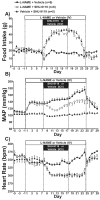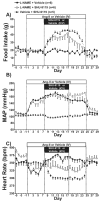Chronic central nervous system MC3/4R blockade attenuates hypertension induced by nitric oxide synthase inhibition but not by angiotensin II infusion
- PMID: 25287400
- PMCID: PMC4267912
- DOI: 10.1161/HYPERTENSIONAHA.114.03999
Chronic central nervous system MC3/4R blockade attenuates hypertension induced by nitric oxide synthase inhibition but not by angiotensin II infusion
Abstract
We examined whether central melanocortin 3 and 4 receptor (MC3/4R) blockade attenuates the blood pressure (BP) responses to chronic L-NAME or angiotensin II (Ang II) infusion in Sprague-Dawley rats implanted with telemetry transmitters, venous catheters, and intracerebroventricular cannula into the lateral ventricle. After 5 days of control measurements, L-NAME (10 μg/kg/min IV, groups 1 and 2) or Ang II (10 ng/kg/min IV, groups 3 and 4) were infused for 24 days, and starting on day 7 of L-NAME or Ang II infusion, the MC3/4R antagonist SHU-9119 (24 nmol/d, n=6/group; groups 1 and 3) or vehicle (saline 0.5 μL/h, n=6/group; groups 2 and 4) was infused intracerebroventricularly for 10 days. A control normotensive group also received SHU-9119 for 10 days (n=5). L-NAME and Ang II increased BP by 40±3 and 56±5 mm Hg, respectively, although heart rate was slightly reduced. MC3/4R blockade doubled food intake and reduced heart rate (≈40 to ≈50 bpm) in all groups. MC3/4R blockade caused only a small reduction in BP in normotensive group (4 mm Hg) and no change in rats receiving Ang II, although markedly reducing BP by 21±4 mm Hg in L-NAME-treated rats. After SHU-9119 infusion was stopped, food intake, heart rate, and BP gradually returned to values observed before SHU-9119 infusion was started. Ganglionic blockade at the end of L-NAME or Ang II infusion caused similar BP reduction in both groups. These results suggest that the brain MC3/4R contributes, at least in part, to the hypertension induced by chronic L-NAME infusion but not by Ang II.
Keywords: CNS; blood pressure; food intake; heart rate.
© 2014 American Heart Association, Inc.
Figures



References
-
- Fan W, Boston BA, Keterson RA, Hruby VJ, Cone RD. Role of the melanocortinergic neurons in feeding and the agouti obesity syndrome. Nature. 1997;385:165–168. - PubMed
-
- Huszar D, Lynch CA, Fairchild-Huntress V, Dunmore JH, Fang Q, Berkemeier LR, Gu W, Keterson RA, Boston BA, Cone RD, Smith FJ, Campfield LA, Burn P, Lee F. Target disruption of the melanocortin-4 receptor result in obesity. Cell. 1997;88:131–141. - PubMed
-
- Balthasar N. Genetic dissection of neuronal pathways controlling energy homeostasis. Obesity. 2006;14:222S–227S. - PubMed
-
- Farooqi IS, O’Rahilly S. Genetic of obesity in humans. End Rev. 2006;27:710–718. - PubMed
Publication types
MeSH terms
Substances
Grants and funding
LinkOut - more resources
Full Text Sources
Medical
Miscellaneous

